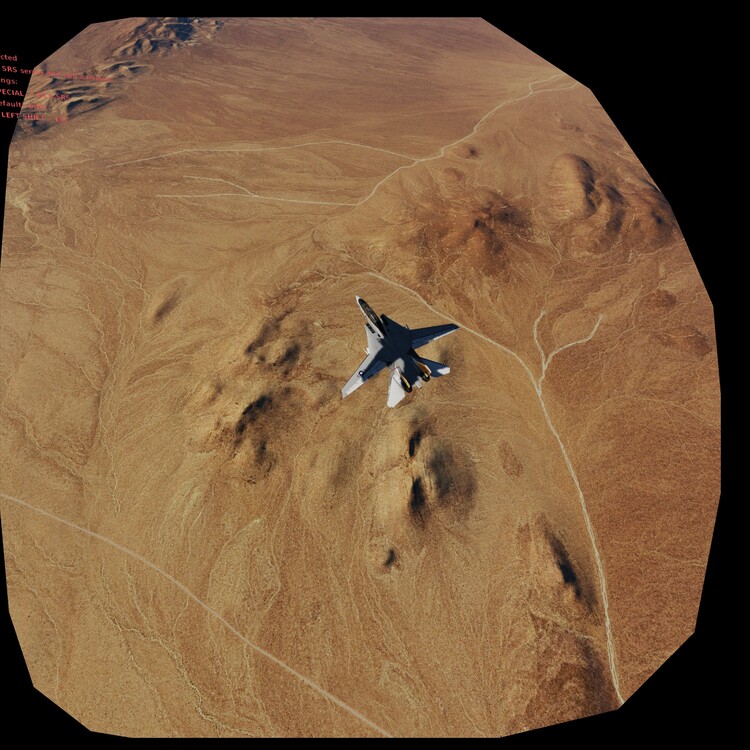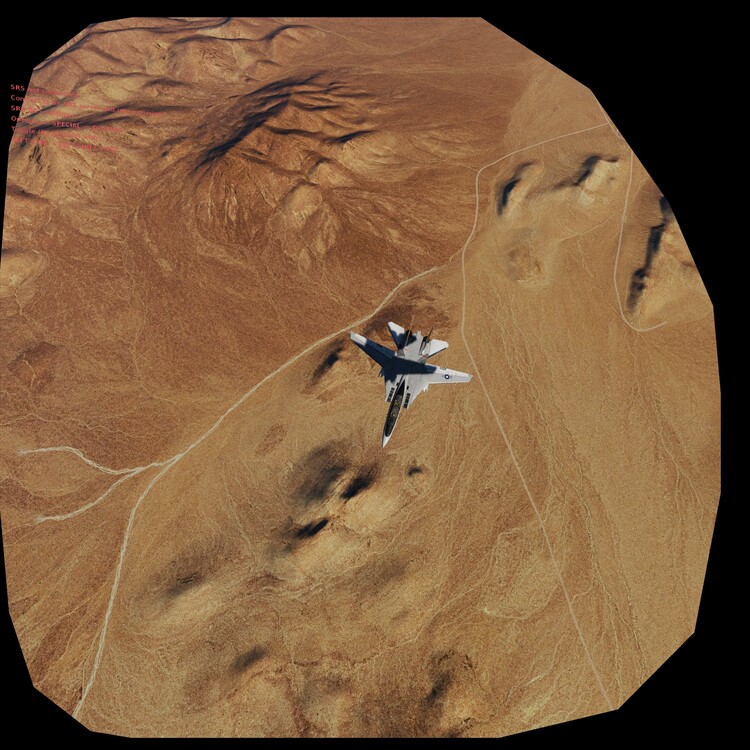-
Posts
314 -
Joined
-
Last visited
-
Days Won
1
Content Type
Profiles
Forums
Events
Everything posted by Quid
-
Thank you for the clarification!
-
For question 1, they would have had PTIDs installed. The F-14A and pre-upgrade B couldn't "talk" to LANTIRN without it (lacked the databus, had to be wired for LANTIRN separately, and interacted with the pod and other systems using the PTID).[1] For question 2, those CBUs don't appear to have any laser package installed, so I'm guessing the LANTIRN is there for buddy-lasing, but will defer to someone with better knowledge. Sources: 1. Lake, Tony (ed.), F-14 BOMBCAT, The US Navy's Ultimate Precision Bomber, Air Forces Magazine, 1 Jan 2015, 32-33.
-
https://heatblur.se/fmupdate/ Those 0.1-0.2deg/sec deviations (+ or -, by the way) in regions of the envelope less than .1M wide are not putting the plane "with steroids," nor handicapping it in any significant way on the "-" side. It's pretty close to the manual data. Where, then, are you getting this?
-
sLYFa is correct. Just to amplify, the F-14B and F-14D each weigh close to 44,000lbs totally empty (43,600lbs and 43,735lbs, respectively) which includes trapped fuel, oil, the gun, sub pylons without rails, and the aircrew (average). The F-14B in DCS is always carrying at least the AIM-9 launchers on the multi-purpose-pylon stub. The F-14B also normally carries BOL chaff dispensers on the launchers making the total weight of the launcher somewhere in the vicinity of 122lbs (90lbs/LAU-7, 31.74lbs/BOL dispenser) per rail (244lbs total), so the total would be very close to 44,000lbs. I'm not certain where the lower numbers come from, unless they were from early block Tomcats - the 1975 NATOPS has an empty weight listed of 40,070lbs, but the F-14A in DCS is in a 1990s configuration, for which the empty weight was 42,000lbs.
-
Sheer performance, the "B," but I also enjoy the "A" for a number of reasons, not the least of which its history, amazing 1970s high-viz liveries, and the challenge of employing it.
-
And Bio Baranek calls it a fourth. Duck Auten and Hawk Smith referred to the F-14 as a third in the same sense as the F-15 was a third (referring to the F-14 as the "first third generation" fighter and binning the Air Force F-15 as the second, so by that logic, the F-22 would be a fourth). Again, not well defined and it's hair splitting, but both FX and VFX were their Service's replacements for the F-4, both using lessons learned from Vietnam, the F-15 programatically was actually older than the F-14 (starting 1967 vs. 1968), flew a scant year and a half later, and didn't have all the same technologies of either the F-14 or the F-4 (no strike) until about 20 years later. Both were designed to fill the same role, both were "next generation" to the Phantom II, both were reactions to a need for a fighter that could dogfight. So, I consider the entire Teen-series a single generation. Even the light-weight aircraft were built for the same purpose: make a plane less expensive that either FX (LWF) or VFX (VFAX), and resulted in a "high-low" mix of fighters (cost-wise), either or meant to augment the more expensive fighter. So, you say third, I say fourth, and neither of us will change the other's opinion.
-
-
Think that became a thing with the Sealed round and I've definitely seen it on a VF-2 F-14D once, but I don't recall it being a standard configuration and have never seen photo evidence on an A or B, so Naquaii's probably spot on for the Tomcats we have in DCS.
-
[Sarcasm] No, we're getting nothing at all ever again. The early F-14A, Iranian F-14A, F-4, A-6, and EF-2000 are nothing more than a CIA cover operation to get your money to fund operations in Val Verde against the cartels. Heatblur has lied to you like John Matrix to Sully. [/Sarcasm] I do apologize for that, and I mean no offense. I write it out of the frustration of reading comments like "I haven't heard about this in a few months, it must be cancelled" in subforum after subforum. No. It isn't. These projects take years. The F-15E was announced first back in 2012 with the first images released in 2014. It should be released shortly, but that's a decade. The Tomcat took what was it, 3.5 years to go from announcement to EA? How many other projects got announced, impatience causes people to claim "it's dead!" and then three months later there is a new update, and the hype train comes back, excitement, then right back to "haven't heard, is it cancelled?" with annoying consistency. Add to this the fact that HB is continuing to develop the flight model, weapons, avionics, etc., etc., etc., and now they are trying to emulate analog RWR tones and displays that they have openly stated both the early F-14A (and Iranian F-14A) and F-4 are reliant upon to simulate accurately. God knows what sources they've had to scrounge up to do it right. Also, HB have stated the IRIAF F-14 is going to be an approximation, so I'd recommend managing expectations. Keep patient, eventually, you'll have your remaining two (not one) F-14s.
-
Correct. The first "all aspect" IR variant of the AIM-9 was the AIM-9L. I make this caveat because someone may quote the AIM-9C, which was a SARH AIM-9 (seeker was called the semi-active radar alternative head (SARAH)) and was all-aspect because it was radar guided, but was also never fired in anger and wasn't considered useful against fighters, not necessarily because of the missile seeker, but because of the F-8's radar tracking reliability and limitations especially at low altitudes. The AIM-9B/D/E/G/H/J/N/P (excepting later "P" series that received comparable capabilities to the later AIM-9L and M) and export variants based on them were rear-aspect missiles.
-
It appears the IRIAF (former IIAF) F-14 cockpit is in English. There is a YouTube video showing a variety of HUD modes in the plane from an Iranian channel, which also shows the HSD, VDI, and ACM Panel, and all of the lettering is in English and appears the same as for a USN Tomcat. It can be found here: There's also a picture of an IRIAF F-14 front seat cockpit in Cooper and Bishop's "Iranian F-14 Tomcat Units in Combat," and while the picture is relatively low resolution, one can make out larger print lettering, such as "ACM" next to the ACM switch, "ALT" on the altimeter, "FUEL" and "QTY" on the fuel gauge, and for the smaller lettering, although it isn't as readable, it appears very similar to what we see in Navy F-14As. Considering this and the video evidence, I'd say with some degree of confidence that Iranian F-14s got delivered with English cockpits and continue to use them to this day. While I'd assume the same for the F-4 and F-5, I'd have to look around for evidence.
-
I have an HP Reverb G2 and I can read everything in the Tomcat cockpit, no mods needed (not that I'm going to criticize anyone who uses a clean cockpit mod, I love the look of a "just delivered" Turkey myself!) and I also haven't figured out how to zoom with a headset on and consider it irrelevant because I can see clearly everything I need to. If there is anything I really want to get down precisely, I lean forward.
-
D-Hose = Da Hose = The Hose = Hoser [Satrapa]. He would sometimes sign "D-Hose" instead of "Hoser."
-
I'm assuming (and we all know where that leads) that for the F-4E on release, it will be the "older" strobe style at least initially. Reason being that I recall HB mentioning that a key to the "early" F-14A (really, the F-14A until roundabouts 1999-2000-ish when it finally started getting the ALR-67 installed) and the F-4 was modelling the ALR-45/50 and comparable systems with their unique sounds and strobes. If the F-4E is supposed to be in roughly Vietnam War era configuration on release, then I'd expect strobes and vectors, not alphanumeric. If they choose to model a later F-4E in the future, then I'd expect the latter at some point.
-

Performance/FM Development Status DCS 2.8.3.37556 Open Beta FEEDBACK
Quid replied to maxsin72's topic in DCS: F-14A & B
It's highly dynamic and will change significantly with altitude and airspeed. Most basically, the higher you are, the less thrust the engine produces, the faster you are, the more thrust it produces, but the relationship is not linear and looks like a curve. The F-14's thrust will also be affected by the variable inlets. These things having been said, for point performance, at static (as in 0 altitude, 0 airspeed, full blower on the cat waiting for launch) the TF-30's military power is rated at 10,875lbs installed thrust/engine. -

Performance/FM Development Status DCS 2.8.3.37556 Open Beta FEEDBACK
Quid replied to maxsin72's topic in DCS: F-14A & B
@maxsin72: While there is the NATOPS that describes it, here's an unclassified, unlimited distribution document that studies deeper into the subject of wing rock in the F-14: https://archive.org/details/DTIC_ADA243109 Describes AOA, severity related to AOA, configurations and how those affect wing rock, etc. Might be good to review. -

Feedback Thread F-14 Tomcat - Update 10th March 2023
Quid replied to IronMike's topic in DCS: F-14A & B
Congratulations on the latest release. The frame rates are wonderful in VR! I've noticed a potential bug: In Multithread mode, there appears to be a shadow artifact in the F2 view when the camera is between the sun and the F-14 (specifically noticed with the F-14B). It seems to flicker a bit and almost seems as though the camera is casting an F-14 shaped shadow on the player's Tomcat. Please see attached pictures. -

Think the F-15 Release is/will have an Impact
Quid replied to Czechnology's topic in DCS: F-4 Phantom
Personal opinion is that the F-15E will have no impact whatsoever on the F-4 release. It typically takes many months to years after an official announcement for a module to actually come out. With the F-4, we haven't seen a single system video, flight model video, etc., like we did for the F-14 and now F-15E, and those start (again) months to years before the module is actually ready for release into early access. While HB has stated they're far along with the F-4, until I start seeing those videos, I won't even consider how far away the module is from release. If it comes out in 2023, great! I intend to buy it even though I almost only fly the Turkey. The F-4 is a piece of Americana that I will not suffer to lack in my hangar. But, given that we have very little other than an announcement video and an official forum, I'm estimating it will be many months before the Phabulous Phantom actually releases into EA. I doubt seriously there will be interference by the F-15E by the time the F-4 is ready. -
Question/Answer 2 should give you roughly what you're looking for.
-
For the missile types, based on the -34 from 1973, it would be the AIM-4D, AIM-9B/E, AIM-7D/E/E-2. The AIM-9J was apparently brought into South East Asia in 1972 (not added to the -34). If HB's intent is a 1974 or 1975 aircraft, it might also have the AIM-9N. WRT missile reliability, I think you answered your own question with the second half of your post. DCS doesn't simulate random failures of missiles. They never come off stupid, they never drop and fail to fire their motor, they never fail to separate, they aren't flown 50 times before being off-loaded for servicing and are literally dead on the rail, etc. So, I'd expect like all missiles in DCS they will always come off, fire their motor, all of their systems will power on, the missile will begin tracking, and it will only be thrown off by chaff or maneuvering.
-
For the numbering, I'm guessing because the AWG-9 entered development before the AWG-10; the AWG-9 conceptually started with the F6D Missileer program and actually began development for the F-111B. Something else, the AN/AWG-9 designator applies to the F-14A/B's radar while the AN/AWG-10 designator is the F-4J's fire control (or missile control) system working with its AN/APG-59 pulse doppler radar (the F-14's fire control system is the AN/AWG-15). I'm not nearly as well read on the F-4 as I am the F-14, but even the HAVE DOUGHNUT Tactical manual separates AWG-10 performance from APG-59 performance specifically WRT fire control (e.g., "The capability of the AWG-10 missile control system was partially degraded by the inherent weakness associated with the tactical employment of the pulse doppler mode of the APG-59 radar" [1]). I'm aware that some folks use the AWG-10 designator to refer to the F-4J's radar, but that doesn't seem correct - rather the AWG-10 is the fire control system used in conjunction with the APG-59 radar. Either way, I'll let a Phantom Phanatic explain because they could do a lot better than me. Sources: 1. Defense Intelligence Agency, HAVE DOUGHNUT-Tactical (Vol II), 1 August 1969 (Declassified 23 Mar 2000), 2-37.
-
HAVE DOUGHNUT-Tactical (Vol II) (published 1 August 1969, declassified 23 Mar 2000, and released publicly 29 October 2013 through the George Washington University's National Security Archive) discusses the APQ-72 (F-4B), APQ-109 (F-4D), APQ-120 (F-4E) and AWG-10/APG-59 (F-4J) performance vs. the MiG-21. Some summations: The APQ-109 acquired the MiG-21 on average 5-10% further away possibly due to the difference in beam width and redesigned radar reflector. Head-on co-altitude, average detection was 20NM with an average lock-on achieved at 15NM. [1] Tail aspect detected at 25NM and tracked at 17NM on average. [1] Abeam, detection averaged 35NM and tracked at 28NM. [1] Ground clutter at lower altitudes complicated the radar tracking problem. Both the APQ-109 and APQ-120 were practically blind looking down, and using the auto-acquisition mode in a look-down scenario is also not useful as it only sweeps 12,500 feet, leaving no-time for a forward quarter shot. [2] The F-4B's APQ-72 performed comparably, but aspect was not provided: 5-15K Feet saw a max detection of 32NM, and an average 20-25NM. Track range maximum was 18NM and average 15NM. [3] 15-30K Feet saw a maximum detection of 40NM, average of 30-35NM. Track range was 27NM max and 25NM average. [3] The F-4J's APG-59 fared far better in Pulse Doppler modes; apparently the pulse mode was worse at high altitudes. The APG-59 averaged 45NM forward-quarter detection with a maximum range of 62NM, and on two occasions, the F-4J spotted the MiG-21 immediately upon takeoff from 15K feet (look-down), detecting, acquiring, and tracking by 50NM. [4] There's some things to keep in mind, of course; I have no idea how they tweaked the APQ-120 (if at all) from 1969 to the mid-1970s (roughly the period the first F-4 Headblur releases is supposed to be representing); the document mentions an expanded auto-acquisition mode to 30,000 feet would be desirable, but this still doesn't change the limitations of a pulse radar looking down, and I don't know if "desirable" became a requirement and actually happened.. Also, if the F-4E is coming with AIM-7Es, it's good to have SA earlier on, but your engagement range is still less than the average head-on tracking range of the APQ-120. Also, although this shouldn't need to be stated, a large fighter or a bomber would be seen further away. Suffice to say, I don't plan on being able to see a MiG-21 rooting around in the dirt from long ranges, at least until a model with a PD radar is released. Sources: 1. Defense Intelligence Agency, HAVE DOUGHNUT-Tactical (Vol II), 1 August 1969 (Declassified 23 Mar 2000), 1-33. 2. DIA, HAVE DOUGHNUT, 1-34. 3. DIA, HAVE DOUGHNUT, 2-36. 4. DIA, HAVE DOUGHNUT, 2-37.
-
F-14A roundabouts 37-38K, F-14B roundabouts 35K.






